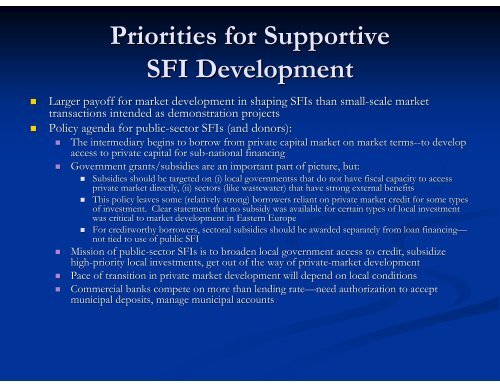LOCAL GOVERNMENT BORROWING - ppiaf
LOCAL GOVERNMENT BORROWING - ppiaf
LOCAL GOVERNMENT BORROWING - ppiaf
You also want an ePaper? Increase the reach of your titles
YUMPU automatically turns print PDFs into web optimized ePapers that Google loves.
Priorities for Supportive<br />
SFI Development<br />
• Larger payoff for market development in shaping SFIs than small-scale scale market<br />
transactions intended as demonstration projects<br />
• Policy agenda for public-sector<br />
SFIs (and donors):<br />
• The intermediary begins to borrow from private capital market on market terms--<br />
--to develop<br />
access to private capital for sub-national financing<br />
• Government grants/subsidies are an important part of picture, but:<br />
• Subsidies should be targeted on (i) local governmentss that do not have fiscal capacity to access<br />
private market directly, (ii) sectors (like wastewater) that have e strong external benefits<br />
• This policy leaves some (relatively strong) borrowers reliant on private market credit for some types<br />
of investment. Clear statement that no subsidy was available for r certain types of local investment<br />
was critical to market development in Eastern Europe<br />
• For creditworthy borrowers, sectoral subsidies should be awarded separately from loan financing—<br />
not tied to use of public SFI<br />
• Mission of public-sector<br />
SFIs is to broaden local government access to credit, subsidize<br />
high-priority local investments, get out of the way of private-market development<br />
• Pace of transition in private market development will depend on local conditions<br />
• Commercial banks compete on more than lending rate—need authorization to accept<br />
municipal deposits, manage municipal accounts
















